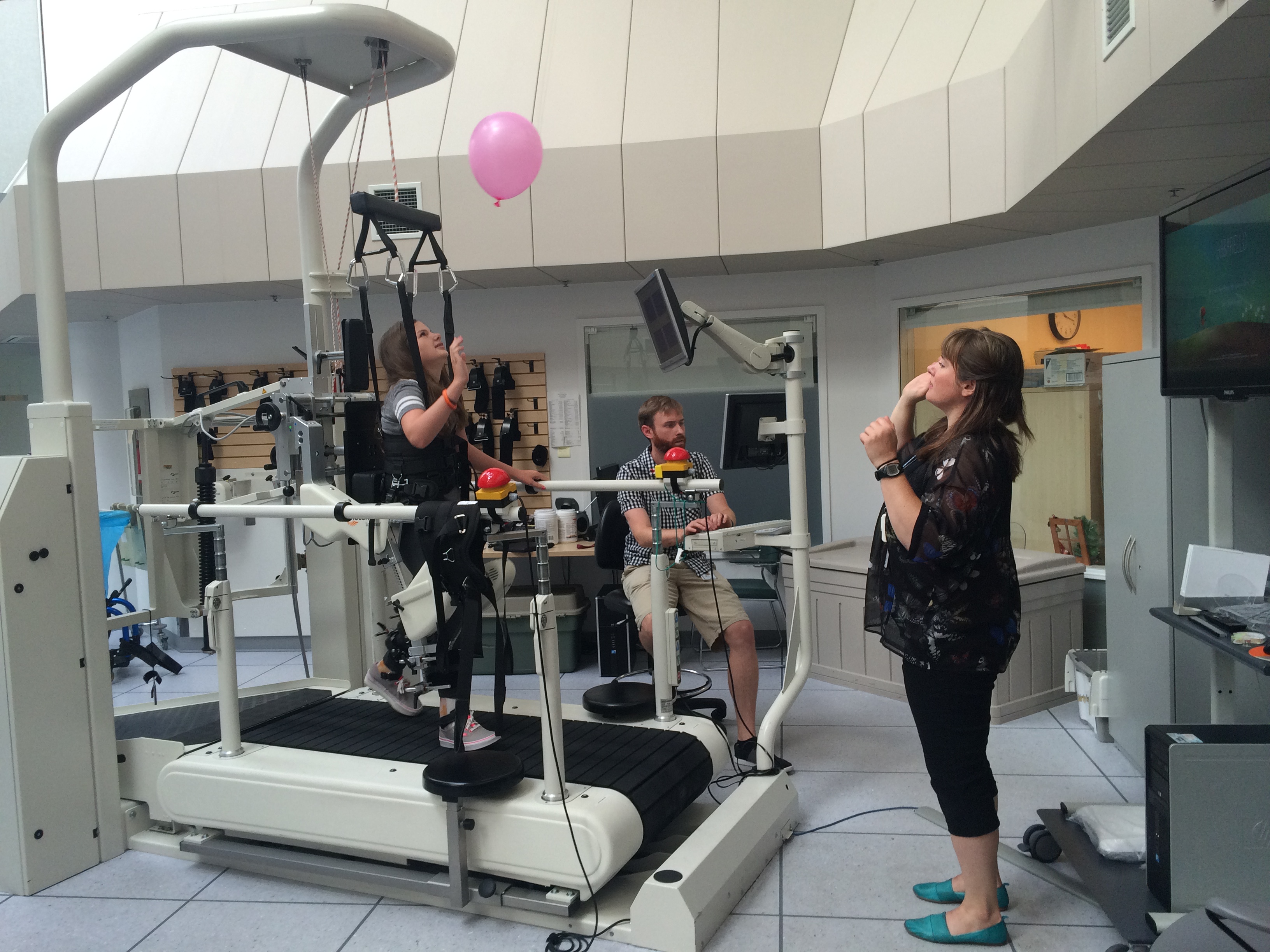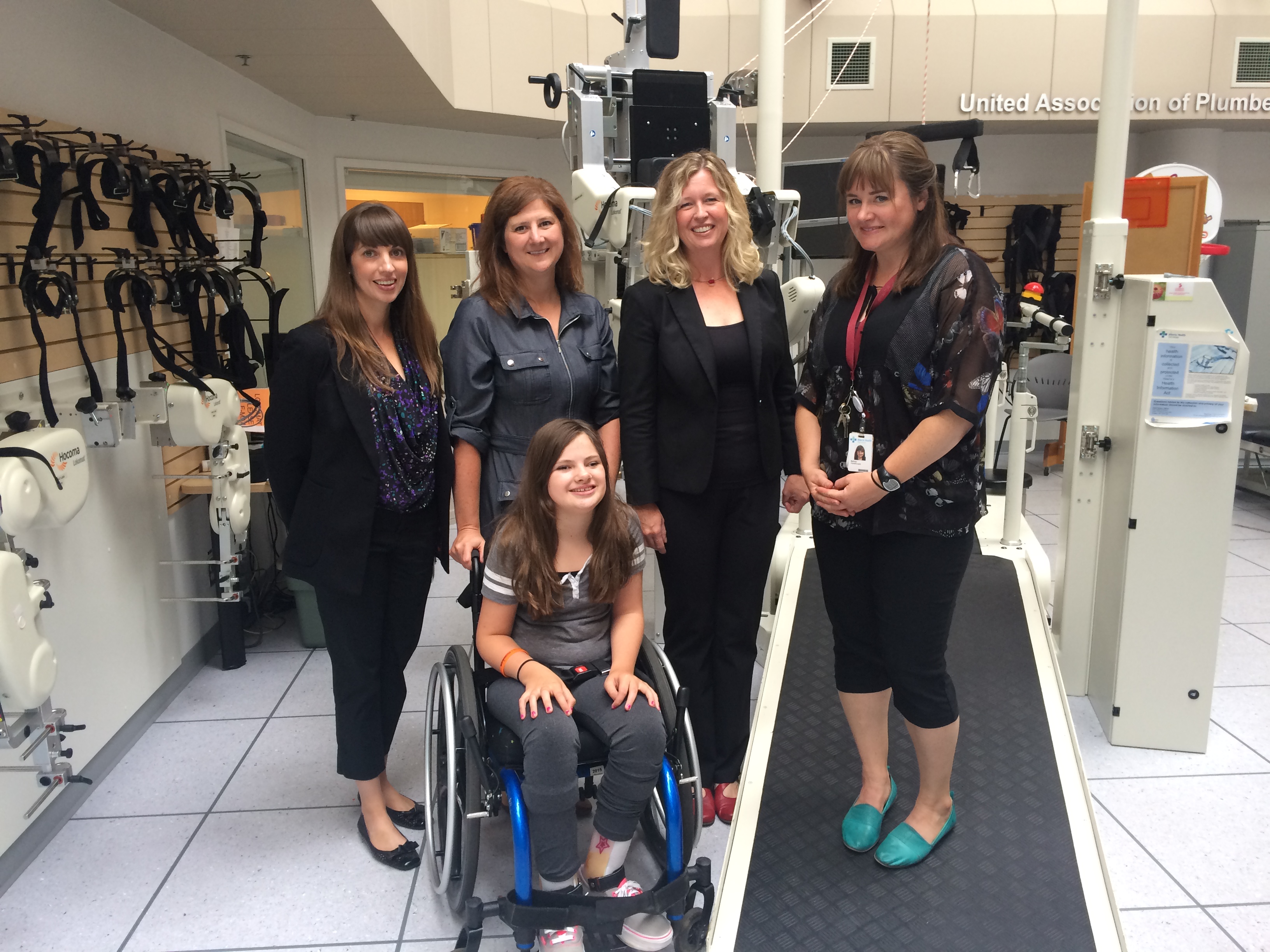
Maggie Slessor practises walking on the Lokomat while tossing a balloon back and forth with a physical therapist at the Glenrose Rehabilitation Hospital.
Maggie Slessor's friends think she's a robot.
Every two weeks, the 12-year-old goes on the Lokomat robotic gait training device as part of a University of Alberta research study at the Glenrose Rehabilitation Hospital.
"My friends think it's really cool when I show them the pictures. They think I'm a robot!" says Slessor, who has spastic diplegia, a form of cerebral palsy (CP). "It's great to be able to walk without having to hold on to anything."
Slessor is part of a randomized control trial led by Lesley Wiart, assistant professor of physical therapy at the Faculty of Rehabilitation Medicine. Wiart and her team are evaluating the effectiveness of a robotic gait training program (Lokomat) compared with regular physical therapy for enhancing walking abilities of children and youth with cerebral palsy. The U of A is currently recruiting more children and youth to be part of the study.
The Lokomat is a robotic gait training device. The robotic legs guide the child through walking movements on a treadmill. The device supports the child's body weight so they move their legs more freely. The body weight support and the amount of guidance is decreased over time to more closely replicate regular over-ground walking. There is a video game connected to the Lokomat that provides feedback on the force the child is generating.
"Research evidence for robotic gait training for children with cerebral palsy is limited," says Wiart, who is also a research associate at the Glenrose Rehabilitation Hospital. "We are doing this study so that families and clinicians have information about effectiveness and they can make informed decisions about physical therapy treatment."
Teaming up with Virginia Wright, senior scientist from Bloorview Research Institute in Toronto, Wiart explains that the study is a randomized controlled trial with a qualitative component conducted at three sites: Glenrose Rehabilitation Hospital, Holland Bloorview Kids Rehabilitation Hospital in Toronto and Rehabilitation Institute of Chicago. The study is comparing different interventions to see which are more effective. Children and youth with CP will be placed in four groups: robotic-assisted gait training, regular physical therapy, a combination of robotic-assisted gait training and regular physical therapy, and no treatment.
"We are interested in how the treatment affects walking but also how it affects the child's confidence to participate in physical activities and their participation in other activities in their homes and communities," says Wiart. "In the qualitative part, we will talk to parents and children about their beliefs and values about walking and why their mobility goals are important to them. It is essential to understand families' goals and values about walking, because many families are more focused on ensuring their child can move around effectively and are less focused on how their child moves."
For Wiart and fellow researcher Shanon Phelan, the qualitative aspect of the research is just as important.

Maggie Slessor with (L-R) researcher Shanon Phelan,
mom Doreen, researcher Lesley Wiart and physical
therapist Kelsey Switzer
According to Maggie Slessor's mom Doreen, it wasn't just about walking for Maggie either.
"I've seen how the Lokomat has motivated Maggie and given her confidence. It's also helped her have more confidence walking with a cane," Doreen says. "She'll probably give me a hard time for saying this, but it's also helped with her gut motility!
"Maggie loves the blend of Lokomat and traditional physical therapy. She's always asking, 'When can I go on the Lokomat again?'"
Maggie smiles in agreement. "I love the activity and exercise on it. I know what 'tired' feels like now," she says.
The Lokomat in Edmonton is provided by the Glenrose Rehabilitation Hospital Foundation. John Andersen and Rhonda Rosychuk are also part of the Edmonton team led by Lesley Wiart.
The CIHR-funded study is currently recruiting children and youth with cerebral palsy aged five to 18 years who walk with or without handheld walkers. If families are interested, please contact lokomatstudy@ualberta.ca or 780-492-9098.